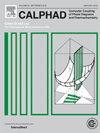The power of computational thermochemistry in high-temperature process design and optimization: Part 2 – Pyrometallurgical process modeling using FactFlow
IF 1.9
3区 材料科学
Q4 CHEMISTRY, PHYSICAL
Calphad-computer Coupling of Phase Diagrams and Thermochemistry
Pub Date : 2024-12-13
DOI:10.1016/j.calphad.2024.102772
引用次数: 0
Abstract
Computational thermochemistry is an essential tool when it comes to the design of new industrial pyrometallurgical processes. It also enables the optimization of existing processes by analyzing the effect of various operating conditions on key indicators such as the metal recovery, the product composition, the direct emissions and the process overall energy balance. The modeling of these complex processes requires the use of multiple streams and equilibrium reactors in order to perform a large series of thermodynamic calculations. It also needs to account for the kinetic limitations of key chemical reactions. Current thermochemical software restricts users to single equilibrium reactor calculations or necessitates advanced programming knowledge to build customized pyrometallurgical processes.
In this work, we introduce a new process simulation interface called FactFlow, a multi-stream/multi-unit process simulator embedded in the FactSage package. It offers an intuitive and efficient interface for handling streams, performing equilibrium calculations and allowing the use of stream recycling loops. It also uses the extensive thermodynamic databases available in FactSage to describe the energetics of oxides, sulfides, carbides, salts and metallic phases. This new process simulator interface enables the solving of mass and energy balances of a wide range of pyrometallurgical processes related to the primary production of iron and ferroalloys, copper, titanium and more. In this work, this new interface is used to describe four pyrometallurgical processes, i.e. (i) ferrosilicon alloy production using a submerged arc furnace, (ii) the primary production of copper and the impact of E-waste recycling using a Noranda-like process, (iii) the primary titanium production via the Kroll process, and (iv) the production of direct reduction iron ore pellets via the MIDREX process. Results of the simulations performed in this work are systematically compared to data available in the literature.
计算热化学在高温工艺设计和优化中的作用:第 2 部分 - 使用 FactFlow 建立火法冶金工艺模型
计算热化学是一个重要的工具,当它涉及到新的工业火法冶金过程的设计。它还通过分析各种操作条件对关键指标(如金属回收率、产品成分、直接排放和工艺总体能量平衡)的影响,实现现有工艺的优化。这些复杂过程的建模需要使用多个流和平衡反应器,以便执行大量的热力学计算。它还需要考虑关键化学反应的动力学限制。目前的热化学软件限制用户单一平衡反应器计算或需要先进的编程知识,以建立定制的火法冶金过程。在这项工作中,我们引入了一个新的过程模拟接口FactFlow,它是一个嵌入在FactSage包中的多流/多单元过程模拟器。它提供了一个直观和高效的界面处理流,执行平衡计算,并允许使用流回收循环。它还使用FactSage中广泛的热力学数据库来描述氧化物、硫化物、碳化物、盐和金属相的能量学。这个新的过程模拟器接口能够解决与铁和铁合金,铜,钛等初级生产相关的各种火法冶金过程的质量和能量平衡。在这项工作中,这个新的界面用于描述四种火法冶金过程,即(i)使用埋弧炉生产硅铁合金,(ii)使用Noranda-like工艺生产铜的初级生产和电子废物回收的影响,(iii)通过Kroll工艺生产钛的初级生产,以及(iv)通过MIDREX工艺生产直接还原铁矿石球团。在这项工作中进行的模拟结果与文献中提供的数据进行了系统的比较。
本文章由计算机程序翻译,如有差异,请以英文原文为准。
求助全文
约1分钟内获得全文
求助全文
来源期刊
CiteScore
4.00
自引率
16.70%
发文量
94
审稿时长
2.5 months
期刊介绍:
The design of industrial processes requires reliable thermodynamic data. CALPHAD (Computer Coupling of Phase Diagrams and Thermochemistry) aims to promote computational thermodynamics through development of models to represent thermodynamic properties for various phases which permit prediction of properties of multicomponent systems from those of binary and ternary subsystems, critical assessment of data and their incorporation into self-consistent databases, development of software to optimize and derive thermodynamic parameters and the development and use of databanks for calculations to improve understanding of various industrial and technological processes. This work is disseminated through the CALPHAD journal and its annual conference.

 求助内容:
求助内容: 应助结果提醒方式:
应助结果提醒方式:


